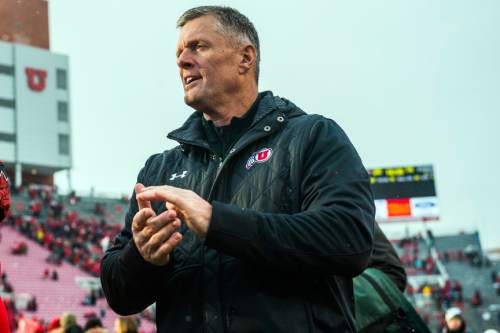This is an archived article that was published on sltrib.com in 2016, and information in the article may be outdated. It is provided only for personal research purposes and may not be reprinted.
Now that the days of evaluation and the day of renewal are over with, the days of hard work begin.
National Signing Day came and went, with Utah and BYU mostly getting the players they targeted and also suffering bits of hidden disappointment. But the endeavor, at both schools, was judged by the respective coaches as a success, just like it is every year.
Never heard a coach yet say, "Yeah, we got a bunch of dogs this time around. We got skunked. Our recruiting ineptitude set us back. We're gonna suck."
Kalani Sitake, who characterized his recruiting experience at BYU as a six-week sprint, after his hiring in December, said: "We're really pleased with the talent we're bringing onto our team. We got a lot bigger and stronger, then, also, we got lengthy. We also got some speed."
Kyle Whittingham said, "We're really excited about this class. Our assistant coaches did an outstanding job of evaluating and targeting the right guys. We won some crucial head-to-head battles with some stiff competition, so that was good to see. We made more headway in that regard than any recruiting class ever, as far as competing with 'heavyweights' and coming away with some really good players."
Thing is, neither of the coaches' noses were blowing through a window.
They did get good players, based on many evaluations, players who not only can make a contribution to the programs, but who can make a difference in them. However, it's still a crapshoot as to which, and how many, players will do what.
If you believe the national recruiting rankings, Utah finished 36th in one, and BYU hung at 50. Other rankings jostled those numbers around.
Still, if you look at the Utes, who a lot of people are saying had their best recruiting class since joining the Pac-12, there were six league opponents who ranked above them: USC, UCLA, Stanford, Oregon, Arizona State and Washington.
Precisely what that means is difficult to determine.
Perennial power schools like Alabama, Ohio State, Florida State, LSU, Michigan and Georgia landed in the recruiting top 10. Those schools will probably be good because of raw numbers. But judging individual players by the number of stars by their name is a much trickier business. Nobody knows with any certainty who's going to be what.
"It's not an exact science," Sitake said.
There are surprises. There are disappointments.
Aaron Rodgers was a 3-star. Drew Brees had zero stars. How many stars were next to Alex Smith's name when he arrived at Utah? Exactly.
In past years, if you compared Utah's players, how they were evaluated coming out of high school, to the ranked players on some of the Pac-12 teams they beat this last season, it would underscore the point.
And, yet, quality coaches like Whittingham and Sitake always say, as they did on Wednesday, that it's all about the players, that recruiting is, the way Sitake said it, the "lifeblood" of any program.
If that's true, then why are coaches paid millions of dollars — instead of the players upon whose talents so much rests?
The best answer to that — without firing off in a different direction about the antiquated and bastardized notion and glorification of amateurism — comes in two parts: 1) The coaches draw in the talent, and 2) they organize and motivate it.
If they do enough of that, then they win. And if they win, the process perpetuates itself. That's how and why Alabama nearly every year leads the recruiting rankings.
Whittingham credited Utah's recruiting ascent to exactly that: "Ten wins will do the most good. You hear the term, 'Winning solves everything,' that certainly helps your cause in recruiting. … A lot of these guys want to be a part of what's coming next."
Sitake, a noted recruiter, praised the athletes the Cougars got, but much of his emphasis seemed to be aimed at future recruiting. He said, among other things, that he would target and prioritize top LDS athletes the likes of which have chosen other programs in the past: "We're going to try to find them and recruit them. … There's a bunch of good LDS athletes out there."
Either way, for both Whittingham and Sitake, the pendulum of power has suddenly switched over from the highly rated recruits to the coaches. If the number of stars attached to 18-year-olds' names brought glory before, it brings a whole lot less now. It's up to them to become what they'll be — via development, determination and diligence. It's up to the coaches to get the best out of these guys.
As Sitake said, it's now a matter of "hard work" and "how they come together as a team."
GORDON MONSON hosts "The Big Show" with Spence Checketts weekdays from 3-7 p.m. on 97.5 FM and 1280 AM The Zone. Twitter: @GordonMonson.





